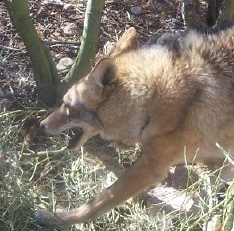
Captured Coyote
|
Coyotes
(continued from Page 1)
Pets
such as free roaming house cats and smaller dogs are considered
legitimate prey species by coyotes. When people
attempt to
feed or otherwise “tame” coyotes, they run the risk of being bitten or
acclimating the wild canines to the point where they lose all fear of
humans and are apt to start looking upon small children as possible
food sources.
The number of
attacks by coyotes on
humans is usually directly related to the behavior of the people within
a coyote’s territory. “Abnormal behavior” on the part of
humans
is likely to draw a similar response from wild
animals.
Distemper,
mange, and rabies are diseases that sporadically affect coyote
populations. Since the rabies virus is both transmittable to
humans and invariably fatal, being bitten by a coyote should be avoided
at all costs.
For the most part coyotes
live both on the
edge of our physical environments as well as on the fringes
of
our imaginations, cunning, wary, and the epitome of a true
survivor. They are the tricksters in numerous Native American
legends and are viewed either as an icon or the scourge of
our
modern desert environment.
A special
thanks to Dexter K.
Oliver for writing this section. |